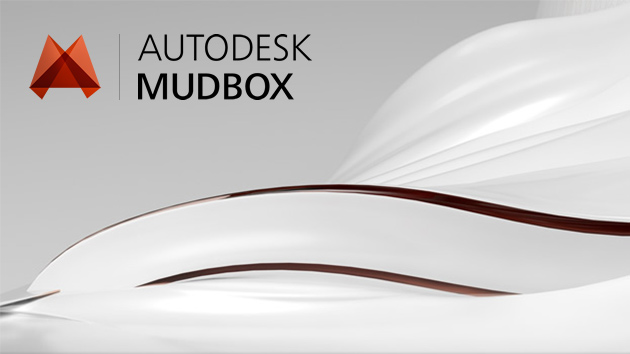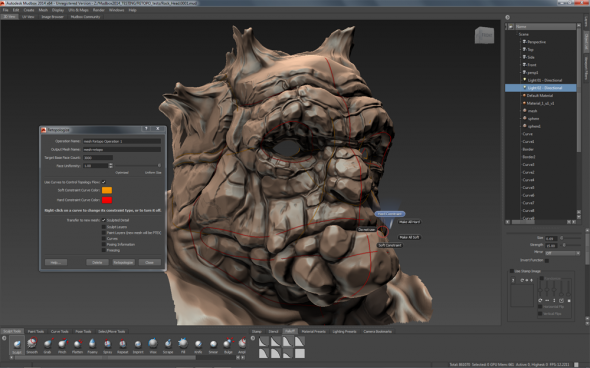New Retopology Workflow Looks Great on Paper, But Isn't Finished
Autodesk has a history of iterative releases of features undergoing development, which can be hit-or-miss for users purchasing expensive upgrades. In this case, Autodesk has unleashed a somewhat unfinished retopology workflow in Mudbox 2014. Regardless, Mudbox is playing catch up to rivals ZBrush and 3D-Coat, which have had excellent retopology tools for years. However, as will be made clear in this review, Mudbox is far from being on the same level as ZBrush and 3DCoat in terms of retopology.
Retopology Demystified
While the process of retopology has been around for some time, it is still a mystery to many. In CGI, topology refers to the surface properties of a 3D model. For instance, how many polygons make up the surface of the model? Is the surface made of triangles, quadrangles (quads), n-gons or all three? Do the edges of polygons flow in useful patterns or are they a gnarled mess? At its most basic, retopology entails producing a new target 3D model from an original source 3D model, where the new topology has been optimized for a specific purpose like animation.
Retopology has become necessary exactly because of the existence of programs like Mudbox, which produce sculpted models with high-frequency details made of millions of polygons with topologies that work for sculpting, but not for animation or even for rendering.
Another common source of models with high frequency-details is 3D-scanned models. 3D-scanning has become very popular with the advent of affordable desktop 3D scanners like the NextEngine scanners. However, since 3D scanning is an automated process, even the best 3D scanners often produce less than optimum topologies for production pipelines.
Retopology involves three critical steps: reducing the number of polygons, producing a uniform mesh made of quads, and directing edge flows into patterns useful for a production pipeline. To reproduce the high-frequency details of the original sculpted or scanned model, maps such as normal maps, displacement maps and vector-displacement maps are extracted from the original and applied to the retopologized model in target 3D applications like Maya, 3ds Max or Blender.
Retopology in Mudbox
In Mudbox 2014, there are two main methods to accomplish retopology operations.
First is the quick Computed Retopology, where Mudbox automatically retopologizes a model based on parametric inputs like desired number of polygons and polygon distribution and uniformity.
Second is Guided Retopology, where curves and edge loops drawn on the surface of the model are used in addition to the parametric inputs to guide Mudbox as to how the model is retopologized.
One of the most reliable ways to retopologize native Mudbox sculptures is using Guided Retopology, which uses user-defined curves to guide the retopology process.
With Computed Retopology, Mudbox automatically and quickly retopologizes a mesh. This works well with native Mudbox sculptures.
There are two types of user-defined curves: Soft Constraint Curves, which suggest edge flow, and Hard Constraint Curves, which explicitly direct edge placement during the retopology process.
Autodesk touts Mudbox's new retopology operations as capable of retopologizing both native Mudbox sculpted models and imported scanned models. In testing for this review, when models sculpted with Mudbox were retopologized, both Computed Retopology and Guided Retopology worked very well, though we experienced the occasional crash. Notably, the Guided Retopology workflow produced very nice edge flows where expected. However, further testing revealed that while Mudbox retopology operations worked for models sculpted in Mudbox, retopology operations on scanned models required considerable preparation (editing of the scanned model) prior to retopology; and even then, in some cases, Mudbox failed to complete some retopology operations.
The Mudbox 2014 retopology tools work well as long as they are applied to models sculpted in Mudbox. However, when attempting to retopologize imported scanned models Mudbox did not perform as expected.
I used many scanned models (including the Stanford Bunny) in multiple trails with Mudbox's retopology tools. In each attempt, Mudbox announced, "Mudbox has detected problems in the imported mesh," followed by specific topology problems like non-manifold vertex or degenerated face. The problem areas on the mesh are highlighted by a red sphere on problem vertices and a red line on problem edges. Thus, before retopologizing, the problem had to be fixed using Mudbox's new Patch, Tighten Selection, and Fair Selection tools, or by exporting the model and cleaning it up in another application. Once cleared of the offending topology problems, the scanned model can be retopologized much like a native Mudbox sculpture.
However, Mudbox's retopology workflow is utterly mind-boggling, because the main purpose of retopology operations is to fix topology problems. If Mudbox requires scanned models to be free of topology problems to retopologize, then what is the point? In sharp contrast, 3D-Coat's Autoretopo tool can almost always tackle even the most gnarled mesh without complaint. Even better, ZBrush's new ZRemesher is a one-click retopology solution. To be fair, Autoretopo and ZRemesher also have limitations, but they are not nearly as daunting as those in Mudbox's retopology operations. Autodesk would do well to add a true automatic retopology operation that handles common topology problems like a stray vertex or non-manifold vertex. After all, if Mudbox is programmed to detect a mesh problem and tell the user about the problem, why can't it fix it?
As mentioned, Mudbox 2014 ships with new mesh editing tools like Patch, Tighten Selection, and Fair Selection to prepare meshes for retopology or to edit retopologized meshes. Mudbox 2014 also features Create Mesh from Curves, a roundabout method to retopologize scanned data somewhat similar in principle to Guided Retopology. The idea is to draw a network of curves on the surface of a scanned model using new and old curve tools to produce a new retopologized mesh based on the curves and various parametric inputs. While Create Mesh from Curves generally works, it is an extremely tedious trial-and-error workflow.
Similar to the Guided Retopology process, the Create Mesh from Curves retopology method will produce a new mesh based on a network of curves drawn on the source mesh. While this retopology works, it is very tedious and requires multiple attempts.
Summary
Overall, both the Computed and Guided Retopology operations in Mudbox 2014 worked well when applied to native Mudbox sculptures. As explained, when retopology operations were attempted with imported scanned models, the retopology operations required models free of common topology problems — which is peculiar, since the main goal of retopology is to fix common topology problems. Nonetheless, it is important to remember that Mudbox is still one of the best 3D sculpting and 2D/3D painting programs available today. Its overall ease of use is unmatched, its comprehensive 3D sculpting workflow is top-notch, and its 2D/3D painting toolset is unrivaled in the industry. Add to that Mudbox's tight interoperability with Photoshop, Maya, 3ds Max, and Softimage and you have a winning solution.
The question, of course, boils down to whether to spend the cash for an upgrade. If Mudbox 2014 is going to be used to retopologize its own sculpted models, then the upgrade cost is justified. However, for retopology of imported scanned models, I cannot recommend upgrading to Mudbox 2014. Maybe Autodesk can improve the retopology workflow in a new patch for 2014 or in the next release. Until then, users are better off sticking to their 2013 (or older) version of Mudbox and using other software for scanned data retopology.















Leave a Reply